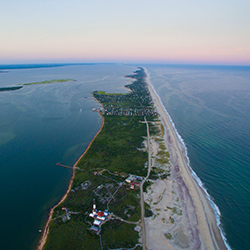2012 – During hurricane Sandy, Fire Island put to use their unique system of sand dunes. While the hurricane destroyed some of the oceanfront properties, the dunes served their purpose. The wave heights at the tallest reached 9.6 meters high with winds averaging at about 90mph. The consequences could have been far more devastating if it weren’t for the sand dunes that shielded most of the island’s 4,500 homes. The sand dunes were 10 to 20 feet high, and absorbed most of the impact. Other areas on Fire Island that did not have sand dunes, were not as fortunate with the outcome of the storm and had their homes destroyed. Since Fire Island had such an advanced system of sand dunes, new dunes were replaced just a few years ago after Fire Island residents agreed to refinance the project.
2013 – Blizzard Nemo hit Long Island, with 30 inches of snow. Almost 10,000 businesses and homes on Long Island lost power. The ferry service was suspended during this time, limiting transportation to and from the Island.
2014 – A Nor’easter came to shore on Fire Island. Freezing water and flooding flooded streets and caused damage to homes. The flooding was over two feet on Ocean Beach in Fire Island, making roads impassable. Almost 100 people were stranded during the time, and all passenger and freight service on Fire Island were suspended. The sand dunes were leveled, which flooded streets and destroyed docks and property.
2015 – Winter storm Juno halted transportation on Fire Island. Flights were cancelled and the Long Island Rail Road was down. Fire Island had about 2 feet of snow and 60 mph winds. Roads were barely passable, and residents were urged to stay home. Major coastal flooding was caused from the storm, which created dangerous waves that ripped apart docks, scraped away beaches and exposed pipes and utility cables along the shore.
2016 – Winter Storm Jonas caused high surf from heavy winds. An hour after high tide, waves were blocked by trap bags. The tide caused low level erosion and hit the sand fencing. Fortunately, the high tide quickly left. The winds from the winter storm made powerful waves, but the trap bags did their job at protecting the island from further damage. Nearly 2 feet of snow from the storm blanketed the entire Island.
2017 – The Fire Island beach dried up after tidal flooding due to a nor’easter. Streets were flooded with about a foot of water, which required a few days to cleanup. Flooding with high winds of 40 mph along with snow, sleet and ice caused road closures. There was no access to the ferry on Fire Island. A lot of the flooding could have been prevented with new bulks and dockheads. Many people lost power, and snowfall up to 3 inches per hour were observed.
Storms of The Past:
1693 -A Major hurricane in 1693 caused severe damage to Long Island. Due to high winds and strong waves, the Fire Island Cut was created.
1938 – The New England Hurricane of 1938, also known as the Long Island Express, hit Suffolk County. The category 3 hurricane had 18 ft waves, wind gusts of 125 mph and washed ashore destroying many houses on the water. There were 8,900 houses and 2,600 boats destroyed, with 60 deaths just in New York. Total deaths including surrounding states were 682. The damages were estimated at 4.7 billion. 35 percent of New England’s trees were wiped out by the storm. Due to the lack of technology to track a Hurricane, residents were not warned of the storm and there were no evacuations ordered.
1961 – Hurricane Esther hit Suffolk County in 1961, causing coastal flooding, winds gusts of 108 mph and 260,000 homes went without power. The tropical Cyclone was the first storm to be discovered on satellite imagery. The damage cost 3 million in 1961, which is now equivalent to about 20 million. The tides were from 4-6 inches on Long Island, and as a result of the storm, a Navy Plane crashed North of Bermuda.
Fire Island has come a long way with preparing for storms. Years ago, the casualties from these storms were much higher, as many people were not prepared. Today, technology has allowed us to see major storms ahead of time, so we could prepare to evacuate if needed. Sand dunes and trap bags along the coast have helped to contain a lot of the flooding on Fire Island in the recent years. They have been shown effective since Hurricane Sandy, and will continue to be used by the Island to prepare for future storms.
Fire Island is filled with history. Come see for yourself why Fire Island has become an annual destination for so many people. From historic landmarks to beautiful beaches, your visit at Fire Island will be the trip of a lifetime.








